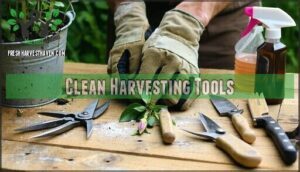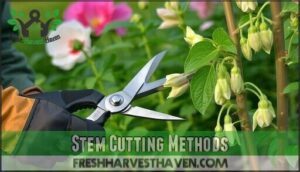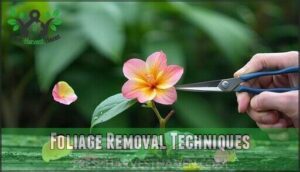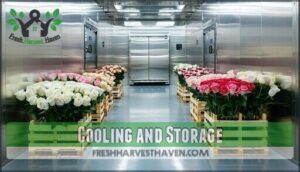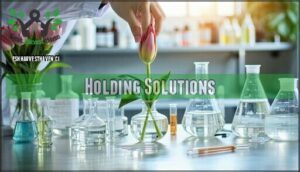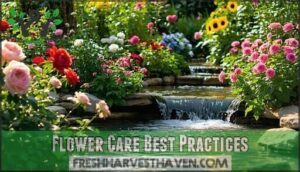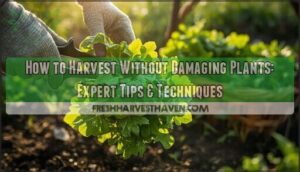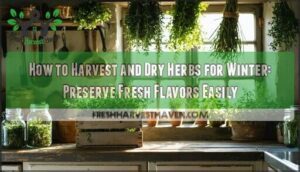This site is supported by our readers. We may earn a commission, at no cost to you, if you purchase through links.
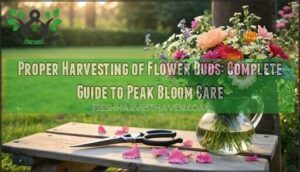
Use sharp, clean tools to make angled cuts just above a leaf node, then immediately place stems in cool water.
Choose buds that show color but haven’t fully opened yet, as they’ll continue developing in the vase.
Remove lower leaves to prevent bacterial growth, and work quickly to minimize stress on your flowers.
Even seasoned gardeners sometimes miss the sweet spot between too tight and too open.
The difference between good and exceptional flower longevity often comes down to mastering these fundamental techniques and understanding how environmental factors affect your harvest timing, which requires proper harvesting and a good grasp of when to make the perfect cuts.
Table Of Contents
- Key Takeaways
- Pre Harvest Planning
- Harvesting Techniques
- Post Harvest Handling
- Environmental Conditions
- Flower Care Best Practices
- Frequently Asked Questions (FAQs)
- How do you know your buds are ready to harvest?
- How long do you let buds dry after harvest?
- What should buds look like when ready?
- What is the best time of day to harvest buds?
- How to pick a flower so it grows back?
- How to properly harvest flowers?
- How to pick flowers correctly?
- What temperature do you store fresh cut flowers at?
- How do pollinators affect harvest timing?
- Can flower buds be harvested during rain?
- Conclusion
Key Takeaways
- Time your harvest for early morning hours when stems are fully hydrated and temperatures are cool—this single timing decision can extend your flowers’ vase life by several days.
- Cut stems at 45-degree angles just above leaf nodes using sharp, sterilized tools, then immediately place them in cool water to prevent air bubbles from blocking water uptake.
- Choose buds that show color but haven’t fully opened yet since they’ll continue developing in the vase while lasting significantly longer than fully opened blooms.
- Remove all foliage below the waterline and work quickly during harvest to minimize stress—bacterial growth from submerged leaves is one of the fastest ways to kill your cut flowers.
Pre Harvest Planning
You’ll want to start planning your flower bud harvest long before you pick up those shears, because the secret to gorgeous, long-lasting blooms begins weeks earlier with smart cultivar choices and timing.
The difference between wilted disappointments and show-stopping arrangements often comes down to selecting the right varieties, watching the weather like a hawk, and knowing exactly when those buds hit their sweet spot for cutting.
Plant Cultivar Selection
Your cultivar choice sets the foundation for harvesting success.
Choose your varieties like you’re picking a winning team—genetics determine whether you’ll celebrate or cry at harvest time.
You’ll want to select varieties bred for stem strength and color vibrancy**—these traits directly impact your flower’s market appeal.
Prioritize cultivars with proven disease resistance, as healthy plants produce superior bud quality throughout all flower development stages.
Look for varieties specifically bred for cutting suitability and postharvest longevity.
Strong genetics matter more than you’d think—they’ll determine whether your buds open beautifully or disappoint customers.
Research shows that selecting the right cultivar can boost harvest efficiency by 25-35% while extending vase life substantially.
Weather Conditions Impact
Weather conditions directly impact your flower harvest success more than you might expect.
Rainfall damage creates perfect breeding grounds for mold and fungal diseases, while excessive sunlight exposure above 30°C causes premature bud opening and wilting.
Temperature extremes below 10°C delay flower maturation, creating uneven bud sizes that hurt your harvest quality.
Wind effects strip delicate petals and knock blooms flat before you can cut them.
Smart growers practice climate monitoring and plan around seasonal variation to avoid these pitfalls.
Install frost protection systems and monitor humidity levels closely—when conditions exceed 90% humidity combined with high temperatures, Botrytis infection risk skyrockets.
Time your harvest during favorable environmental conditions for healthier blooms.
Plant Environment Considerations
Your plant environment sets the stage for premium blooms.
Soil composition needs proper drainage and nutrients, while air circulation prevents fungal issues.
Sunlight exposure should be bright but not scorching—think filtered morning light.
Water availability maintains plant turgidity without waterlogging roots.
Monitor humidity levels and temperature control to optimize environmental conditions before harvest.
Minimum Harvest Maturity Stage
Timing is everything in flower bud harvesting—get it wrong, and you’ll watch your blooms wilt faster than ice cream in July. Species variation plays a huge role in determining the perfect bud maturity stage for optimal harvest time.
Here’s your roadmap to nailing the timing:
- Monitor bud development closely—look for firm, plump buds with vibrant color intensity
- Test aromatic compounds by gently squeezing; mature buds release their signature fragrance
- Assess visual appeal through proper color development and petal formation stages
- Consider vase life requirements—some flowers need tight bud stage, others prefer partial opening
Understanding proper harvesting techniques guarantees you’ll capture peak aromatic compounds and maximize visual appeal, giving your customers blooms that’ll last.
Harvesting Techniques
Now you’re ready to transform those vibrant buds into stunning cut flowers that’ll last for days.
The key lies in using the right techniques at the perfect moment—think of it as giving your flowers the VIP treatment they deserve from garden to vase.
Optimal Harvest Time
When it comes down to flower bud harvesting, morning vs evening makes all the difference. Early morning harvest captures peak hydration levels and maximum aroma intensity, while bud development reaches prime maturity between 6-9 AM.
Your best harvest time hinges on watching bud maturity indicators like firmness and color density. Oil content peaks before noon, so don’t sleep in!
Proper cooling methods, such as forced-air cooling, can also help preserve quality.
Monitor these harvesting techniques daily:
- Feel that satisfying snap of perfectly turgid stems
- Watch buds transform from tight promises to colorful revelations
- Smell the concentrated fragrance that screams "pick me now!
Clean Harvesting Tools
Sharp harvesting tools make the difference between prize-winning blooms and wilted disappointments. You’ll need sterilization methods like alcohol wipes or bleach solutions between cuts—think of it as surgical precision for your garden.
Tool maintenance keeps your sharp tools performing flawlessly, while contamination prevention protects delicate flower buds from disease. Ensuring proper sanitation is key, and you can find sterilization supplies readily online.
Sharpness importance can’t be overstated: dull blades crush stems, blocking water uptake. Proper tool storage in dry conditions prevents rust and maintains cutting edges.
| Tool Type | Sterilization Frequency |
|---|---|
| Pruning Shears | Between each plant |
| Harvest Knife | Every 30 minutes |
| Buckets | Start of each session |
| Cutting Surface | After each variety |
| Hand Tools | Between garden sections |
Master these harvesting techniques and your harvesting tools will reward you with healthier, longer-lasting flower bud harvesting results.
Stem Cutting Methods
Master precision cuts by positioning your shears at a 45-degree cutting angle just above a leaf node placement. This sweet spot maximizes water absorption while preventing stem damage.
Underwater cutting eliminates air bubbles that block hydration pathways. Remember tool sterilization between plants—cross-contamination kills blooms faster than Monday morning meetings.
- Clean cuts heal faster and resist bacterial infections better than jagged tears
- Consistent stem angle creates uniform arrangements while optimizing water uptake mechanics
- Stem singeing for latex-producing varieties prevents excessive sap loss during transport
Foliage Removal Techniques
After you’ve mastered stem cutting, it’s time to tackle leaf striping like a pro.
Remove all foliage below the waterline to prevent water contamination and bacterial prevention—think of submerged foliage as bacteria’s favorite hangout spot.
Use sharp, clean shears for stem cleaning, cutting just above each leaf node.
This technique varies by species variation, but the goal remains consistent: expose your flower buds while maintaining their aesthetic impact and extending vase life through proper foliage management.
Post Harvest Handling
Once you’ve carefully harvested your flower buds, the real work begins with proper post-harvest handling that’ll make or break their vase life.
You’ll need to act quickly with cooling, hydrating solutions, and proper storage to maintain those peak blooms you worked so hard to grow.
Cooling and Storage
Now that you’ve harvested your flower buds properly, you’ll need rapid cooling to lock in their freshness.
Cool harvested buds to 33-35°F immediately—think of it as hitting the pause button on aging. Your temperature control system becomes your flowers’ best friend, slowing respiration and preserving those vibrant colors.
To further extend shelf life, consider pre-cooling techniques immediately after harvest.
Cooling Methods and storage solutions that work:
- Maintain humidity levels at 90-95% to prevent dehydration
- Use ethylene mitigation filters in your cooler systems
- Guarantee proper air circulation around stored buds
- Monitor temperature management with reliable thermometers
- Store different flower varieties separately for superior bud storage
Hydrating Solutions
After cooling your buds, hydrating solutions become your secret weapon for peak flower preservation. These specialized mixtures boost water uptake by 25-30% compared to plain water alone.
| Component | Amount | Purpose |
|---|---|---|
| Citric Acid | 0.1-0.2% | Solution pH control (3.5-4.5) |
| Aluminum Sulfate | 100-300 ppm | Antimicrobial protection |
| Biocide Benefits | As directed | Prevents bacterial growth |
| Wetting Agents | Small amount | Enhances water movement |
| Water Temperature | Room temp | Ideal absorption rate |
Commercial solution recipes like Chrysal Professional work great if mixing chemistry isn’t your thing. You can purchase hydrating solution products online.
Recut stems and soak for 2-4 hours—this simple step prevents xylem blockage and reduces wilting by 40%. Your flower care best practices start here, setting the foundation for extended vase life through proper postharvest handling.
Holding Solutions
After hydration comes the next step—holding solutions keep your buds fresh longer.
You’ll mix Solution pH between 3.5-4.5 using citric acid, while Biocide Use prevents bacterial blockages.
Sucrose Benefits include supporting bud opening with 1-2% sugar content.
Perfect Hydration Timing means soaking stems 4-24 hours in these Solution Recipes.
Your postharvest handling becomes a science experiment—bud preservation that delays flower senescence better than basic hydrating solutions.
Think of holding solutions as flower vitamins that extend vase life by 3-7 days!
To maintain freshness, consider using a holding solution biocide.
Vase Solutions
After holding solutions prepare your flowers, Vase Solutions become your final line of defense.
Commercial Floral Preservatives deliver precise Solution pH (3.5-4.5), sugar for nutrition, and Biocide Use to fight bacteria.
These Hydration Solutions extend vase life by 50-150% compared to plain water.
Smart Water Quality management plus Preservative Benefits keep blooms stunning longer—because wilted flowers aren’t anyone’s idea of success.
Environmental Conditions
Once you’ve harvested your flower buds, controlling their environment becomes essential for maintaining peak quality and extending their lifespan.
Think of it as creating a spa retreat for your blooms – the right temperature, humidity, and air quality can mean the difference between flowers that last days versus weeks.
Temperature Management
Temperature control becomes your secret weapon once flowers leave the field. Cooling Methods and proper Storage Temperatures prevent that dreaded wilted-flower disaster.
Smart Temperature Management follows these non-negotiables:
- Drop Field Heat immediately—get blooms to 33-35°F within hours
- Monitor Transportation Temps religiously during moves between locations
- Maintain Cooler Systems with daily temperature checks and clean filters
- Never skip rapid cooling—Temperature Effects compound fast in warm conditions
Your Heat Control strategy determines whether customers see vibrant blooms or sad, droopy disappointments. Thermal Regulation isn’t optional—it’s everything.
Humidity Control
Your flowers need that Goldilocks zone of moisture—not too wet, not too dry. Maintaining relative humidity between 75-99% prevents dehydration while avoiding fungal problems that love excessive dampness.
| Humidity Level | Effect on Flowers | Recommended Action |
|---|---|---|
| Below 75% | Rapid water loss, wilting | Increase humidity, add moisture |
| 75-85% | Ideal for most species | Monitor and maintain |
| 85-99% | Good preservation, some risk | Guarantee air circulation |
| Above 99% | Condensation, fungal growth | Reduce moisture, improve airflow |
You’ll want cooling systems with built-in humidity controls and fans for steady air circulation. Check your moisture levels regularly—think of it as taking your flowers’ pulse.
Storage humidity that’s too high creates condensation on petals, while thermal regulation helps maintain consistent conditions. Condensation prevention becomes your best friend when you balance preferred levels through proper ventilation.
Ethylene Exposure
While maintaining proper humidity keeps your buds fresh, ethylene exposure poses an invisible threat that’ll sabotage your flowers faster than you can say "wilted petals." This sneaky gas accelerates senescence in sensitive species like carnations and orchids, causing petal damage at concentrations as low as 0.01 µL/L.
Ethylene Sources lurk everywhere—from that innocent banana in your workspace to vehicle exhaust near loading docks. Smart Damage Prevention starts with understanding Sensitivity Levels vary by species, making vigilance your best defense. Ethylene production also plays a key role in fruit ripening itself.
- Keep flowers away from ripening fruits and decaying plant matter
- Make certain excellent Ventilation Importance in storage and handling areas
- Apply Antiethylene Treatments like STS or 1-MCP for sensitive varieties
- Monitor with ethylene detection tubes for early warning signs
Proper Inhibitor Use can extend vase life by 3-6 days, transforming potential losses into lasting blooms.
Storage Recommendations
With ethylene control mastered, your blooms need proper Long-Term Storage conditions to stay gorgeous. Cooler systems require dual-zone Temperature Management—maintain 32-35°F for hardy varieties, 50°F+ for tropical treasures that hate the cold. Think of it like climate zones for your flower guests.
Set up dedicated flower storage areas with airtight containers and well-ventilated shelving systems. Your humidity sweet spot? 75-99% prevents that dreaded shriveling nobody wants. Cooling Techniques paired with reliable Hydration Solutions create storage magic.
vase life
Solution Preservatives maintain flower hydration during storage, while proper Ethylene Control prevents premature aging. These storage fundamentals transform wilted disappointments into lasting beauty.
Flower Care Best Practices
Once you’ve harvested your flower buds, proper care techniques will determine whether they’ll grace your vase for days or wilt faster than your enthusiasm for gardening.
These proven best practices cover everything from gentle handling during transport to maintaining crystal-clear water that keeps stems happy and hydrated.
Handling and Transportation
Gentle handling during transportation prevents damage that can shorten vase life by days. Think of your blooms as passengers on a delicate journey—every bump matters.
Use these Transportation Logistics to guarantee safe delivery:
- Apply Minimize Bruising techniques by securing stems in padded containers
- Maintain Temperature Control with insulated transport boxes
- Implement Hydration Methods using water tubes or gel packs
Smart Packaging Solutions protect your investment while handling and transportation becomes seamless, preserving bloom quality from garden to vase.
Water Quality Maintenance
Your water quality maintenance starts with regular water tests—aim for pH levels between 3.5-5.0 for hydrating solutions.
Use filtration methods to remove contaminants and add biocide use to prevent bacterial growth.
Schedule solution changes every 2-3 days and practice thorough container sanitation.
Clean water quality equals longer-lasting blooms that’ll make you smile.
Stem Trimming Techniques
Sharp tools make all the difference in stem trimming techniques. Here’s how to master this skill:
- Tool Sterilization: Clean your shears with rubbing alcohol between cuts to prevent disease transfer and maintain flower health.
- Cutting Angle: Trim stems at a 45-degree angle just above a node placement to maximize water absorption and encourage new growth.
- Underwater Cuts: Recut stems under running water to eliminate air bubbles that block stem hydration pathways.
The cutting angles you create directly impact how well your flower buds absorb water. Think of it like drinking through a straw—a clean, angled cut works better than a crushed end.
These harvesting techniques become second nature with practice, and proper postharvest handling starts with getting the fundamentals right from your first snip.
Regular Maintenance Schedule
Your regular maintenance schedule keeps flower buds thriving throughout their lifecycle.
Start with daily checks—you’ll replace water every two days and perform water tests to prevent bacterial buildup.
Schedule adjustments become necessary as seasons change, requiring more frequent tool maintenance during peak growing periods.
Solution changes happen bi-weekly, while cooler inspection guarantees proper storage conditions.
Don’t forget staff training on proper harvesting techniques and ideal timing for bud development.
To encourage continuous blooming, deadheading flowers weekly is essential.
Here’s your essential schedule:
Daily Checks
Frequently Asked Questions (FAQs)
How do you know your buds are ready to harvest?
You’ll know your buds are ready when they reach the tight bud stage with strong color development but before fully opening.
Check for firm, plump buds with vibrant hues – they’re perfect for maximum vase life.
How long do you let buds dry after harvest?
Did you know drying your buds too fast can cut potency by up to 25%?
Let them dry for 7–14 days in a cool, dark spot, aiming for stems that snap, not bend.
Patience pays off!
What should buds look like when ready?
Ready buds should be tight, firm, and show their mature color without being fully open.
You’ll notice stems are strong, petals feel crisp, and there’s no wilting or browning edges visible.
What is the best time of day to harvest buds?
Like a well-timed sunrise kiss, early morning’s your golden ticket for harvesting buds.
You’ll catch plants at their most hydrated state, typically before 10 AM when they’re bursting with water content and essential oils for maximum vase life.
How to pick a flower so it grows back?
Cut stems at a 45-degree angle just above a leaf node using sharp, clean shears.
This encourages new growth from the remaining node while preventing damage that could kill the plant completely.
How to properly harvest flowers?
Harvest early morning when plants are fully hydrated.
Use sharp, clean shears to cut stems at 45-degree angles above leaf nodes.
Place stems immediately in cool water to prevent wilting and maintain quality.
How to pick flowers correctly?
Like a surgeon’s precision meets nature’s clock, you’ll master flower picking by cutting stems at 45-degree angles early morning when plants are fully hydrated.
Using sharp, clean shears just above leaf nodes for ideal water uptake is crucial.
This technique ensures optimal results, as it allows for the best water uptake, promoting healthy flowers.
What temperature do you store fresh cut flowers at?
You’ll want to store fresh cut flowers at 33-35°F for ideal longevity.
This temperature range slows decay while maintaining high humidity levels of 75-99% to prevent wilting and extend their beautiful vase life.
How do pollinators affect harvest timing?
Pollinators can damage delicate buds when visiting flowers, so you’ll want to harvest before peak pollinator activity. Time your cuts for early morning when bees and butterflies aren’t active yet.
Can flower buds be harvested during rain?
Like Noah watching storm clouds gather, you shouldn’t harvest flower buds during rain.
Wet conditions promote bacterial growth, reduce vase life, and damage delicate petals.
Wait for dry weather to guarantee quality blooms.
Conclusion
Like Goldilocks searching for porridge that’s "just right," mastering proper harvesting of flower buds requires finding that perfect balance between timing and technique.
You’ve learned the essential steps—from pre-dawn harvesting to post-harvest care—but remember that each flower variety has its own personality.
Don’t get discouraged if your first attempts aren’t magazine-worthy; even professional florists had to learn through trial and error.
With practice, you’ll develop an instinct for recognizing ideal harvest timing and executing flawless cuts.


